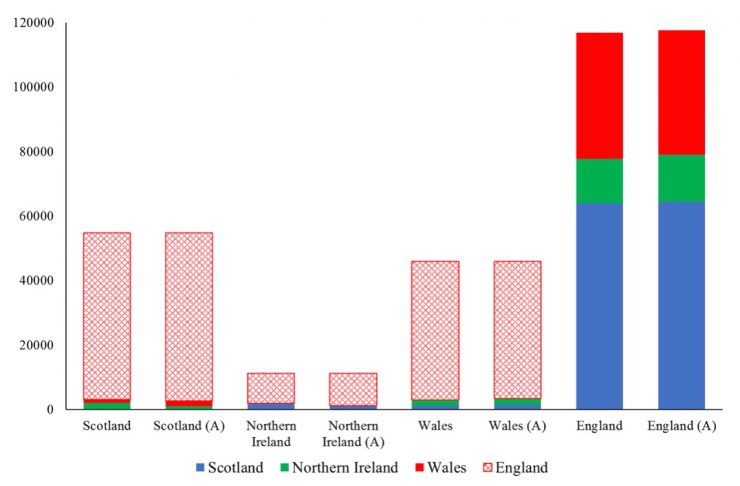By Mairi Spowage and Sharada Davidson
COVID-19 and Brexit will together cause major disruption to UK supply chains which reflect the production and distribution of goods and services. The impact of this disruption is likely to vary across different UK regions. Consequently, detailed regional statistics are needed to analyse differences in economic activity and inform region-specific policymaking and devolution.
Despite these concerns, there are no comprehensive national statistics on interregional trade in the UK. In this blog, we discuss new research which seeks to address this gap, estimating interregional trade between Northern Ireland, Scotland, Wales and England. We propose a framework for estimating interregional trade across eleven different industry groupings (such as manufactured goods and financial services) and produce estimates for 2015. These estimates can be used to consider a wide range of trade-related concerns. For instance, are Scottish trade links with England weaker or stronger than Welsh trade links with England? We can also analyse trade links at the sectoral level. For example, what is the value of Northern Irish exports in utilities to Scotland?
Mairi’s Discussion Paper co-authored with Graeme Roy and Alastair Greig can be found here. The slides from her ESCoE research seminar can also be found here.
Our Method
We use aspects of the method introduced by Thissen et al. (2013, 2019) to estimate European regional trade flows. However, our approach is tailored to the unique UK data landscape which reflects different levels of devolution. The reader should note that in this blog we focus on export flows for illustrative purposes. However, in our paper, we repeat the steps below for import flows and then reconcile the export and import-oriented approaches. For each sector, we follow the steps below to construct export-oriented interregional trade estimates.
Our first step is summarised in Figure 1. We start with existing estimates of exports from Scotland and Northern Ireland to the rest of the UK. These are obtained from regional Supply and Use Tables (SUTs). Importantly, we adjust Scottish exports to the rest of the UK to account for offshore oil and gas activity. We do so using experimental estimates available from the Scottish government. For Wales and England, no official data on trade with the rest of the UK exist. For Wales, we use the 2007 Welsh Economic Research Unit Combined Use Table (Jones et al., 2010), rebasing the data to 2015.

Our second step is summarised in Figure 2. Additional data is used to split the rest of UK flows shown in Figure 1 into flows to each devolved nation. We use different sources of additional data depending on the sector considered. An important example of additional data is freight data, capturing goods transported by road or sea across the UK.

It is now straightforward to obtain English export flows. If, for example, we wish to obtain English export flows to Northern Ireland, we start with exports from the rest of the UK to Northern Ireland recorded in the regional SUT. We then subtract the derived Scottish and Welsh exports to Northern Ireland shown in Figure 2. The remainder or ‘residual’ reflects English exports to Northern Ireland.
Having obtained interregional trade flows for each devolved nation, we must perform one further step. Using freight data, we make an adjustment to account for transport hubs. To give an example of why this is necessary let us consider goods physically moving from Scotland to Northern Ireland. These goods may not originate in Scotland or have a destination in Northern Ireland. This means that they are not Scottish interregional exports or Northern Irish interregional imports.
Interregional Trade Estimates for 2015
We present our interregional export estimates according to destination in Figure 3. We also show how these estimates change if we adjust them to account for transport hubs. Many of our results are as we would expect. In Wales, Northern Ireland and Scotland we find that the majority of UK exports go to England while Scotland is England’s most important export destination. We also find that Northern Ireland and Scotland have large trade deficits with England reflecting the corresponding SUTs which show large trade deficits with the rest of the UK. While Scotland receives 17% of Northern Irish exports in the unadjusted case, the destination mix of Northern Irish exports is most sensitive to adjusting for transport hubs. Adjustment for transport hubs also results in Wales receiving more exports from Scotland than Northern Ireland which we think requires further scrutiny. The Welsh data gap also poses a challenge with the Welsh trade surplus with England in 2007 being exaggerated when rebasing the data to 2015.

Directions for Future Research
In this blog, we have discussed the importance of producing interregional trade estimates and how this can be undertaken given currently available UK data. There is, however, scope to improve these estimates further. During the construction of these estimates, we encountered different approaches to data collection, data coverage and trade estimation across the UK nations. These issues have informed recommendations and proposals we are working on. In future work, we will update our trade estimates using the best currently available data. We will also recommend a framework for the estimation of interregional trade and ultimately a framework for the production of SUTs across the UK nations.
ESCoE blogs are published to further debate. Any views expressed are solely those of the author(s) and so cannot be taken to represent those of the ESCoE, its partner institutions or the Office for National Statistics.









